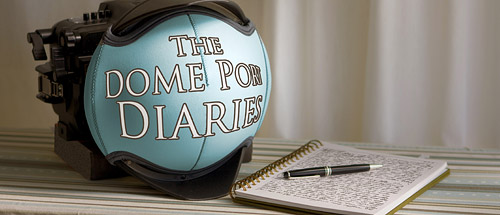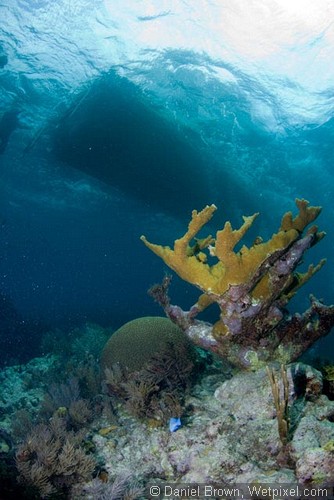Dome Port Diaries - Chapter 8: Season Finale - Into the Blue

CHAPTER 8: SEASON FINALE - INTO THE BLUE
Having migrated the gear from plane to rental car, and from car to dive resort, it was time to unpack and plan the next day. The evening of arrival, (what was left of it anyway), I reassembled the rig. To fit in its Pelican case, I had removed the handles, each wrapped in the socks they give you in Business or First class; a small token along with a slightly wider seat and a “kit” containing toothpaste, a toothbrush, lotion, lip balm, and tissues.
While re-attaching the handles, I had my first panic moment; what the hell did I do with the hex wrench for the handles? Could I have forgotten something so obvious and important? A brief sense of doom and failure washed over me; and the thought of what ELSE had I forgotten? Fortunately, I had the foresight to wrap the wrench with one of the handles. Crisis averted. While there are (usually) no shortage of wrenches in our group, that feeling of having forgotten such an important item can stick with you for a long time.
We would spend the first morning doing “gear-check”; in short, assemble everything and make sure gears turn lenses, cables transfer signals, and batteries are sending power. Then, we’d gather it all up and do an early-afternoon dive. The next few days aim to have the boat loaded promptly (if rarely) by 7:45. This means waking at 7:00, getting dive gear, camera, and caffeine in the blood stream. Kinda tough after a 3-hour time change, mini-nightmares about having forgotten equipment and fears of oversleeping. But this first day starts a bit looser at 9:00-ish. Starting at 9:00 with only camera in hand makes for a good transition day.
The next morning, I woke up, got as dressed up as a tropical environment requires, grabbed my now-housed camera, and headed downstairs. It was hard not to feel like a kid again as I walked toward the classroom filled with other attendees, some of whom are friends who have (and have had for a while) their own rigs. My stride was proud but still a tad awkward with the unfamiliar, valuable, and rather heavy rig in my hands. The transition from warm, moist air to air-conditioning is always a shocking one. In I walked, newly-adopted “baby” in-hand, looking for an empty spot, trying hard not to look like the rookie I felt.
I’m fortunate to have joined Stephen Frink in his week-long seminars for 4 years now (though I’ve known him since that fateful trip in 2001). I’ve heard him say many things before, the same advice to a new audience, but I still manage to learn just a little more with each class. From the earliest and most-obvious advice (get closer) to the intricacies of virtual images and the need for diopters, his advice has transformed my blurry, under-exposed, mostly-green photographs of fish tails into ones I’m proud to put on my walls at home.
I was about to learn another valuable lesson. A student in class was being given guidance about strobes; the very same strobe I was using - Inon. The advice hovered around the importance of diffusers; the diffusers I didn’t bring. Having only occasionally and sporadically managed to put enough light on a subject to yield a decent image, the thought of cutting the light I already found in short supply seemed counter-productive. I had left the diffusers at home; not accidentally, not unwittingly, I left them intentionally. While not the end of the world, I’d need to be creative about how I worked with my one and only non-diffused strobe. The class, having prepped their cameras for a dive, now needed to prep themselves.
Two hours later, we clamored onto the dive boat and quickly filled the camera tables with enough equipment to rival the dollar value of a decent home in Denver. We then assembled the dive portion of the equipment, took roll, and the captain began the journey out into open water. The low drone of the engine makes conversation challenging, so those more in favor of sunlight and less noise climb to the upper deck of the boat for the 45 minute haul. Then, with a a 10-minute warning from the captain, we suit-up.
I let most of the other folks get in the water before I moved my housing, with the utmost-care normally reserved for newborns, to the back and dunked it in the fresh-water “CAMERAS ONLY!” tank. The few bubbles that rose from the housing weren’t followed by any others. After a few seconds, I was convinced it was good-to-go. My turn.
I carried my rig to the back of the boat, slid on my gear, and took those awkward fin-steps toward the back of the boat. Taking my attention for a moment from the camera, I checked the dive gear I’d depend on for little things like BREATHING. My reg wasn’t giving me air. Retracing my steps I realized I hadn’t turned my air on after checking pressure. Again, easily fixable, but another one of those indicators of “things that can go wrong.” Among the many benefits of a dive buddy is that they can quickly and quietly fix silly little mistakes. (Thanks Susan, A.K.A. “Scuba Sue”) I verified the pressure, pushed my mask and reg into place, and did that oh-so-trendy giant-stride into the water. I then turned around to prepare to catch my camera as he lowered it into the water.
The moment of truth had arrived.
For the next hour or so, the housing would literally be the only thing between my camera and a toxic environment which would kill it (and the lens) in an instant if they met.
Monitoring the housing, neither bubbles, nor warning light, nor traces of water were visible, but I gave it a few moments just to make sure. Nothing. A few test shots later, I was convinced. I then purged my BC, and began to descend.
The controls took some getting used to, (it had been two months since my pool tests) and I couldn’t tell if I was in manual mode, but the thrill had begun. By the end of the dive, it had begun to feel more like a friend. I had minimal expectations of the shots from the first dive, but a few images were at least not embarrassing.

Both I and the camera came back up without incident. Now, it was just a matter of practice. My biggest irritation was the buoyancy of the dome port; an issue corrected with a 1-lb. ankle weight. The tweaks had begun.
On our way back, I returned to the upper deck of the boat, the same drone of the engines. I’ve always found the time between dock and destination valuable; goals for shooting over the next few days or how I might improve my shots. Every now and then, we’ll spot dolphins along the way This is inevitably a time when I recognize how utterly fortunate we are to be out there doing what we love; When sun, water, air, friends, and a well-prepared camera can remind me just how much fun life can be.
THE END
by Daniel Brown

Dome Port Diaries
The Adventures of a Newbie Housing Owner